I am building an Wooly Mammoth audio circuit, and I am really interested in finding how and why it works. You can check out and simulate the whole thing here. I must say I haven't been able to get any valuable result from simulation.
It provides a fuzz distortion effect. In fact, it's based in the well-known Fuzz Face. You may notice Q1's collector and Q2's base common node, as well as the feedback net that connects Q1's base and Q2's emitter. In the article I link to, RG Keen makes an extensive analysis and calls that configuration voltage feedback biasing. Unfortunately, I haven't been able to trace any other data about this.
I have isolated the DC circuit for you:

When trying to solve it, I get stuck at proposing and checking hypothesis: I don't really know whether one or both transistors are in saturation region. I assume that, being this kind of effect, at least one of them is. But I find no way to prove it.
One of the Mammoth's addition to the Fuzz face circuit is the Pinch potentiometer. It seems to change the bias point, while users say it works as some sort of noise gate. I have not been able to see that by simulating.
So I would take a good piece of advice on how to solve the DC circuit (is there a possible analytical approach?) to understand the principles of that bias configuration. Also, I would appreciate some help regarding simulation, as I'm sure there must be something useful to get.
Thank you very much.